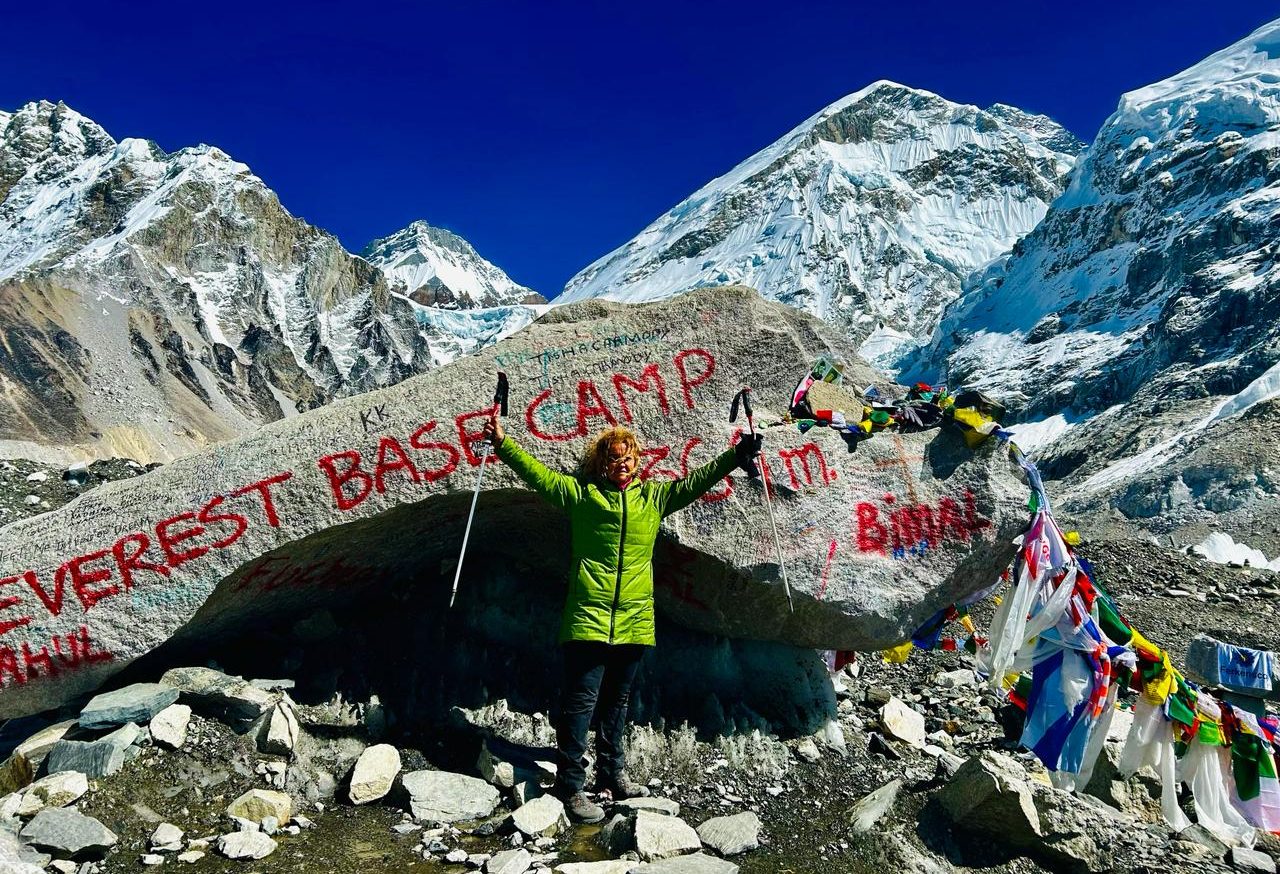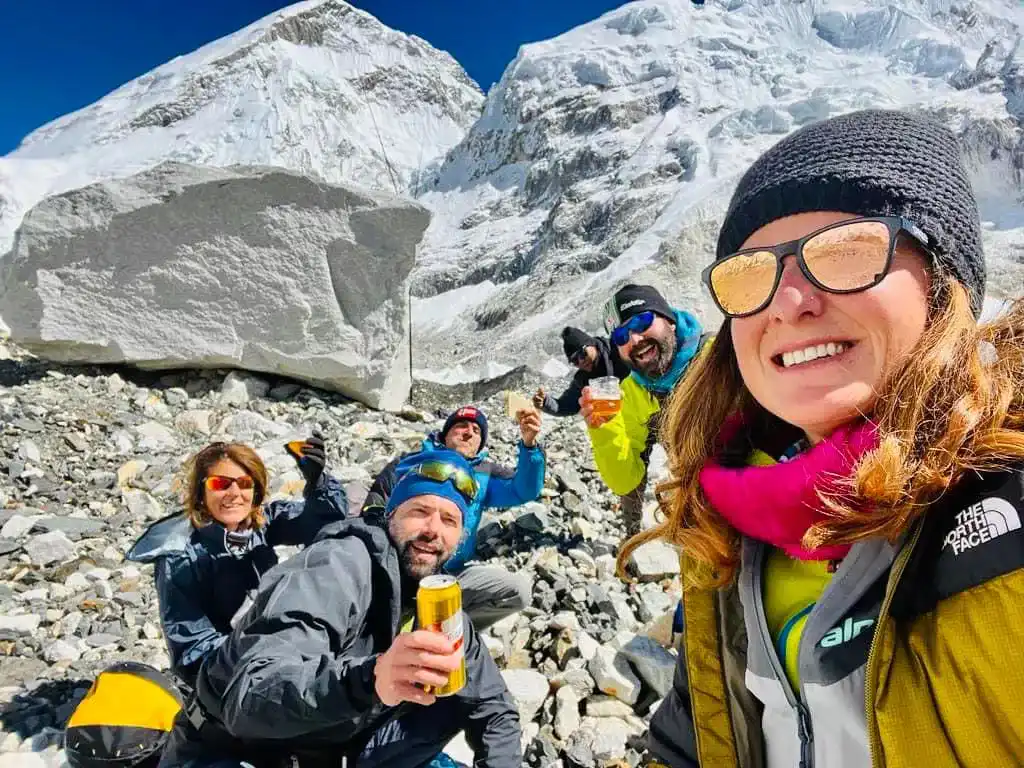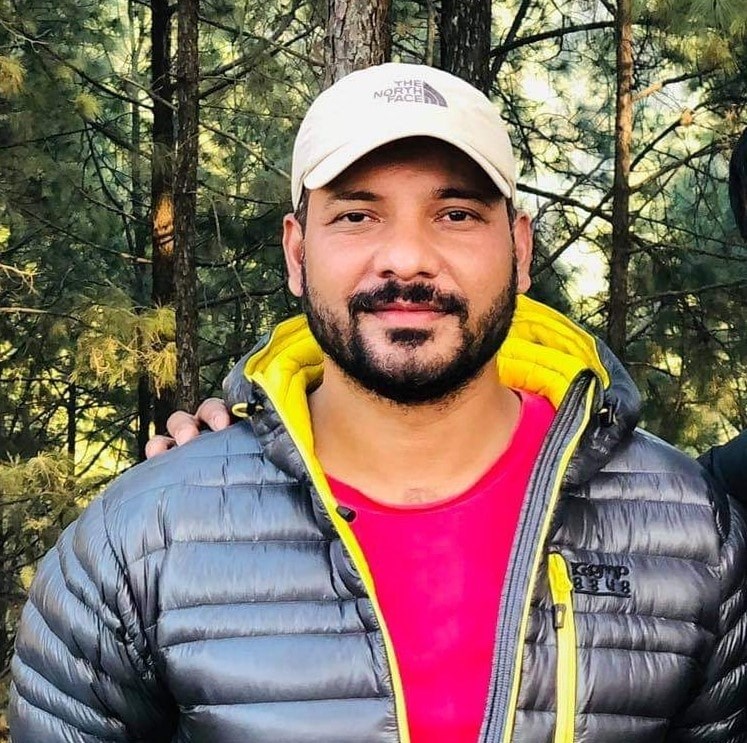The Everest Base Camp trek, which circumnavigates the path towards the foothills of Mount Everest, the highest peak in the world, is the epitome of a sensory feast. This journey offers you an unbeatable adventure amidst the mountains, along with some spiritual exploration rooted in the Khumbu region. Usually, spring and autumn are considered favourable times to embark on this trek. Among them, November shines uniquely by promising a remarkable experience with its pleasant weather and other contributing factors.
The Everest Base Camp trek in November is the perfect choice for anyone wishing to take the challenge one step further. The ultimate adventure, the Everest Base Camp trek in November is framed by the tranquility of Tengboche, the bustle of Namche Bazaar, picturesque settlement areas like Phakding and Gorak Shep, and the surreal scenery of Sagarmatha National Park.
Unveiling the grandeur of mountains, meadows, landscapes, and the Himalayan lifestyle with every step in the Everest region during November is all worth it. Moreover, the peace of mind regarding weather and climate will enhance your adventure to a great extent. So, if you are thinking of embarking on outdoor activities full of wonders and unique prospects, then the Everest Base Camp trek in November offers precisely that and even more.
Table of Contents
Highlights of Everest Base Camp Trek in November

- The exhilarating flight on the Kathmandu Lukla route with a soul-stirring landing on the world’s most treacherous airport, Lukla Airport
- Discover the flora and fauna of Sagarmatha National Park
- Panoramic views of the mountains, including Mt. Everest, Lhotse, Nuptse, Ama Daba, Khumbiyela, Cho Oyu, and many more
- Create abundant memories by spending time with the local Sherpa people
- Cleanse your soul by visiting various gompas, monasteries, mani walls, and shrines
- Traverse through the well-maintained path in the remote severest region to conquer the base of Everest.
What is the Temperature Like in the Everest Region in November?

Coming last to the autumn season, November is far from the monsoonal rain and close to winter, which guarantees a pleasant trekking temperature in the Everest region. However, you should always keep in mind that temperature depends on the altitude. As you ascend to higher altitudes, you will feel a significant drop in temperature.
Furthermore, with ample daylight averaging around 10 hours, you will experience mild temperatures during the day. The morning and nighttime can be quite chilling with some drop in temperature.
As per past data, the temperature at lower elevations like Lukla will range between 6 and 13 degrees Celsius. The higher you elevate towards Namche Bazaar, the temperature will be hovering between 9 and 4 degrees Celsius. Likewise, the temperature in higher elevations like Lobuche and Gorak Shep can drop to minus, ranging between 3 and -11 degrees Celsius. Moreover, the light snowfall during the latter part of November can reduce the temperature, leading to a cold atmosphere in the higher elevations of the Everest region.
The negative figure can make you quite worrisome but worry not. Since November is the last month of autumn, winter will be knocking at the door of the Everest region. So, it is normal to hit minus degrees in the higher elevations. Hence, this is when your proper clothing choices and appropriate packing lists come into practice.
Weather in the Everest Region During November

Everest base camp trek in November offers stable and mild weather, i.e., neither too hot nor too cold. With the arrival of November, the monsoonal rainfall completely subsides, which makes the trail dry, resulting in ideal outdoor walking.
Moreover, the lower precipitation probability makes the weather more stable. Hence, in overall, your Everest base camp trek in November can be a comfortable journey characterized by favorable weather conditions under the blue sky.
Why Everest Base Camp Trek in November?

Since you are here, you must be wondering why November stands out as the best choice for the Everest base camp trek. So, let’s find out some actual deals on why Everest base camp trek in November.
Crisp and Clear Mountain Views
The panoramic mountain views are the main reason for embarking on the base camp treks. Nonetheless, if you choose the wrong time, you may not be satisfied with the mountain views. Fortunately, November saves you from such predicaments.
As the monsoon has far gone, there will be less humidity in the air in November. With less moisture, the skies will have fewer clouds, allowing you to have pristine views of the Himalayan peaks, including Everest, Ama Dablam, Lhotse, Changes, Makalu, Nuptse, etc. On clear days with less fog and mist, you can enjoy these magnificent Eastern Himalayan views without obstruction.
Imagine waking up to such incredible mountain views, walking on the trails with mountains touching the horizon, and ending the day with the crispness of the allure of alpine peaks. Doesn’t this feel like a rewarding adventure?
Festival Delights
Do you know what will make your Everest base camp trek in November more memorable? It’s the festival magic you can celebrate while walking back and forth across Nepalese land. Following the lunar calendar, November has a list of festivals like Tihar, Chaath, Mani Rimdu, etc.
Mani Rimdu is a 19-day festival that is celebrated in the Tengboche region, mainly by Sherpa communities. You can enjoy this incredible festival by being part of their dances, prayers, and feasts while making your way through the Tengboche Monastery during the trek. So, timing your Everest base camp trek in November will give you a wonderful opportunity to learn more about Nepal by discovering its unique culture and traditions.
Enchanting Himalayan Landscapes
Since you will be exploring the Everest region in the fall season, you will be welcomed with the foliage hues of yellow, orange, and red. The rugged landscapes adorned with the golden color as nature continues its traditional cycle will give you a unique perspective of the Khumbu region.
The harvest season will provide you with a plethora of chances to discover the traditional agricultural techniques in the high Himalayas. Traversing the enchanting landscapes full of dense forest and meadows contrasting with white snow-capped mountains is undoubtedly magical.
Meet Many New Faces
Since November is one of the peak times of the year for the Everest base camp trek, you will find many trekkers and nature enthusiasts on the trail and in teahouses. You can use this time to make new friends and socialize with people of various backgrounds. This will help you to socialize and increase the horizons of your friendships. Who knows, an Everest base camp trek in November might forge meaningful friendships or a lifelong companion.
Difficulties of Everest Base Camp Trek in November

Certain factors can make your Everest base camp trek in November quite difficult. These may be avoidable or unavoidable. So, let’s delve deeper into them to learn how you can tackle these difficulties to make your trek more comfortable.
Altitude
Since your dream is to stand at the foothills of mighty Everest, you have already expected of high altitude. This high-point trek will elevate you to a significant height of 5,364 m at the base camp. So, it is quite natural for trekkers to fall prey to altitude sickness.
One can feel the symptoms of altitude sickness above 3000 m from sea level. Additionally, in this trek, you need to cross 5000 m and spend most of your days above 3000 m. So, symptoms like headache, vomiting, insomnia, and shortness of breath might hit you during the trek. So, it is important for you to take the trek slowly and acclimatize properly to avoid altitude sickness.
Unpredictable Weather and Temperature
Given our earlier emphasis on stable weather and mild temperatures during November, encountering difficult factors such as unpredictable weather and temperature might confuse you. But when you are near the high mountains, weather and temperature can be quite unpredictable, with temperatures fluctuating drastically.
Moreover, there will be slight snowfall during the latter part of November, making the trails slippery and causing harsh weather. Hence, proper clothing and equipment are necessary to complete the trek with ease.
Personal Adjustments and Compromises
Everest base camp trek is one of the mainstream trekking in Nepal, so you can expect booked teahouses and lodges during the peak season, like November. Finding accommodation can be quite a hassle. It is better to inform and make advance bookings; otherwise, you won’t have many options to choose from.
Likewise, you will need to make some adjustments as you won’t be getting extraordinary facilities. You will have to pay extra money out of your pocket to have access to facilities like recharging, hot showers, etc. Hence, the trekkers’ adaptability will play a vital role in the Everest base camp trek.
Brief Outline Itinerary
Day 01: Arrival at Kathmandu and Sightseeing
Day 02: Fly From Kathmandu to Lukla and Trek to Phakding
Day 03: Trek From Phakding to Namche Bazaar
Day 04: Acclimatization Day at Namche Bazaar
Day 05: Trek From Namche Bazaar to Tengboche
Day 06: Trek From Tengboche to Dingboche
Day 07: Acclimatization at Dingboche and Hike to Nagarjun Hill
Day 08: Trek From Dingboche to Lobuche
Day 09: Trek to Everest Base Camp and Return to Gorakshep
Day 10: Hike to Kalapatthar for a Sunrise View and Trek Down to Pheriche
Day 11: Trek Down to Namche Bazaar From Pheriche
Day 12: Retrace the Path Back From Namche to Lukla
Day 13: Fly Back to Kathmandu From Lukla
Day 14: Sightseeing and Return Back to Home Country via International Flight
Is Everest Base Camp Trek in November Suitable for Me?

The Everest base camp trek is graded as a moderately difficult trek with no any technical difficulties. However, you will need to cover lengthy distances of 130 km with different rising elevations, which can be pretty strenuous. Likewise, you are required to hike for 6 to 8 hours per day in those rugged terrains. Even though prior trekking experience is not required, the Everest base camp trek requires some high-altitude hiking. This will help novice trekkers to have a general overview of what each day will look like during your 10 to 20-day trek.
Furthermore, the Everest base camp trek in November requires good physical fitness and mental resilience. If you have health issues with your heart, lungs, or joints, it is better to consult with your doctor first. Even though people of any age group can embark on this trek, children below the age of 16 require a guardian, and adults above the age of 70 require some extra considerations.
Preparations for the Trek
You will be spending more than a week in an unfamiliar place amidst the mountains, so it is necessary to make preparations for the trek. Whether it is preparing yourself or making the packing list, each step is crucial and requires equal attention.
Physical and Mental Training
First thing first, Everest base camp in November requires good physical fitness and stamina along with mental tenacity. So, the right set of preparations can enhance your physicality. It is recommended to have training 4 to 6 weeks prior of the trek. There are various plans available in the market. However, workout plans at home are also equally effective with proper consistency in training.
Since you will be walking longer hours on the rugged terrain it is necessary to have physical strength and good stamina level. Moreover, rising slowly to a higher rectitude with a steep ascent will take more oxygen and will test your endurance. So, you can try exercises like push-ups, lunges, dips, deadlifts, weightlifts, step-ups, plank, etc, to develop and increase your core body strength. Likewise, jogging, swimming, cycling, burpee, and other cardiovascular exercises can increase your stamina.
Preparing yourself mentally is equally important as preparing yourself physically. Since this trek will be quite taxing, it is important to cultivate a positive mindset. You have to be flexible and adapt to the unforeseeable circumstances during the trek. Furthermore, you should set realistic expectations to make the trek more rewarding.
Packing List For Everest base camp trek
It is recommended to pack light for the Everest base camp trek in November. Despite packing light, you must not miss essential things. In case you are in a dilemma about your packing List, you can take the below list as a reference.
Clothing
- Woolen hat or beanie, Wide-brimmed cap or hat
- Buff or neck gaiter, Scarf
- Liner gloves, Waterproof gloves, mittens
- Half or long-sleeve shirts, Moisture-wicking t-shirts
- Thermals
- Down jackets
- Waterproof and windproof jackets
- Rain gear
- Fleece pullover, zip hoodie
- Convertible hiking shorts
- Leggings/hiking pants
- Sports bras( for support and comfort)
- Extra pairs of underwear
- Liner socks
- Thermal or woolen socks with fleece
Footwear
- Comfortable and sturdy hiking boots
- Sandals or slippers to use in tea houses
Personal Hygiene and Toiletries
- Toothbrush and toothpaste, Shampoo, body wash, Biodegradable soap
- Quick drying towel, Toilet paper, Wet wipes
- Hygiene products and menstrual products like pads, menstrual cups, tampons
- Insect repellent
- Sunscreen and lip balm with SPF, Moisturizer
- Shaving cream and razor, Deodorants
- Nail clippers
- Tweezers
Trekking Gears
- Trekking poles
- Backpack and Daypack
- Head torch with extra batteries
- Sleeping bag
- Thermos Flask and reusable water bottles
- First Aid Box with necessary medications
- Money Belt
- Route Map
- Sunglasses
- Earplugs and eye masks
- Camera and lenses
- Portable charger and power bank
- Solar charger
- Waterproof cases and bags
- Journals
- Protein bars
Permits For Everest base camp trek
To complete the Everest base camp trek in November, you will require two permits: a Sagaramtha National Park permit and a Khumbu Pasang Lhamu Rural Municipality Permit.
The cost of a Sagarmatha National Park permit will be Rs. 3000 per person for foreign nationals except SAARC nationals. For SAARC nationals, it will be about Rs. 1500. Children under the age of 10 are entitled to free entrance, but necessary documents for verification are required.
Likewise, the Khumbu Rural Municipality Permit will cost about Nrs. 2000 per person. To get this paperwork done, you will need a valid passport and its photocopies with passport-size photos.
Gain Insights On:
- Major Attractions of Everest Base Camp Trekking
- Everest Base Camp Trek Cost From Kathmandu
- Everest Base Camp Elevation Guide
Tips for Everest Base Camp Trek in November

Slow Pace
It is important to remember that the Everest base camp trek is not a race so you should walk at your pace by taking small breaks to catch your breath. Your stride should match with your breathing. Trekking rapidly will cause fast energy draining and provoke altitude sickness. So make sure you do not rush the trek and enjoy every moment of the journey.
Stay Hydrated and Take Nutritious Meals
Staying hydrated is one of the economical ways to avoid altitude sickness. You need to intake about 3 to 4 liters of water daily. Since you will be trekking in mild temperatures, you may not feel thirsty. However, drinking water is necessary. You can fill your bottles with water from tea houses or even use bottled water. It is always a great option to take water-purifying tablets with you.
Likewise, it is normal to feel stuffed and not hungry while trekking. In these cases, you should force-feed yourself rather than skip your meals. It is recommended to eat a nutritious meal with a balanced diet. Staple food daal bhaat tarkari can be a great option.
Withdraw Cash
Nepal still uses cash for trading, so withdrawn cash in functional currency can always come in handy. Moreover, you won’t find ATMs above Namche Bazaar, so withdrawing cash at Kathmandu when you have enough access is a safe option.





